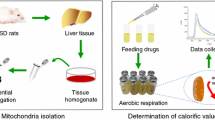Summary
The activities of some glycolytic enzymes and the concentrations of several metabolic intermediates in Hymenolepis diminuta have been evaluated following a 4-hour period of in vitro incubation in the presence of Terenol (generic name: Resorantel), a tapeworm remedy. Resorantel causes a decrease in ATP-, ADP- and glycogen concentrations as well as a simultaneous increase in AMP- and pyruvate levels. These findings indicate a block of the final steps of glucose decomposition and hence an impaired energy metabolism as the cause of the cestodicide drug action. An inhibition of the fumarate reductase as the primary site of action is discussed. Resorantel also inhibits oxygen consumption in mitochondrial preparations isolated from Hymenolepis diminuta.
Zusammenfassung
Nach vierstündiger in vitro-Inkubation von Hymenolepis diminuta in Gegenwart des Bandwurmmittels Terenol (chem. Kurzbezeichnung: Resorantel) wurden in den Zestoden die Aktivitäten einiger Glykolyseenzyme und die Konzentration intermediärer Stoffwechselprodukte bestimmt. Resorantel verursacht ein Absinken der ATP-, ADP- und Glykogenkonzentrationen sowie eine gleichzeitige Erhöhung der AMP- und Pyruvatspiegel. Die Befunde weisen auf einen Block im Endabbau der Glukose und auf eine daraus resultierende Störung des Energiestoffwechsels als Ursache der zestodiziden Präparatwirkung hin. Als primärer Angriffsort wird eine Hemmung der Fumaratreduktase diskutiert. Resorantel hemmt außerdem in Mitochondrienfraktionen aus Hymenolepis diminuta den Sauerstoffverbrauch.
Similar content being viewed by others
Literatur
Becker, W., Humke, R., Tiefenbach, B.: Ergebnisse der klinischen Prüfung von Terenol®. Blaue Hefte für den Tierarzt 43, 75–78 (1970).
Behrens, H., Matschullat, G.: Behandlungsversuche an Schafen mit dem Bandwurmmittel Terenol®. Dtsch. tierärztl. Wschr. 77, 101–104 (1970).
Bergmeyer, H.-U. (Hrsg.): Methoden der enzymatischen Analyse. Weinheim: Verlag Chemie 1962.
Bücher, T., Luh, W., Pette, D.: Einfache und zusammengesetzte optische Tests mit Pyridinnukleotiden. In: Hoppe-Seyler/Thierfelder, Handbuch der physiologisch-und pathologisch-chemischen Analyse; 10. Aufl., Bd. 6A, S. 292–339. Berlin-Göttingen-Heidelberg-New York: Springer 1964.
Bueding, E.: Some biochemical effects of anthelmintic drugs. Biochem. Pharmacol. 18, 1541–1547 (1969).
Christ, O., Düwel, D., Hajdú, P., Kellner, H.-M., Klöpffer, G., Schütz, E.: Über Verträglichkeit und Pharmakokinetik von Terenol® — einem neuen Bandwurmpräparat für Schafe. Berl. Münch. tierärztl. Wschr. 83, 61–65 (1970).
Düwel, D.: γ-Resorcylanilide als Anthelminthika. Proc. 2nd Internat. Symp. „Pharmaceutical Chemistry“, p. 38 (1968).
: Ein neues Zestizid: Terenol® — seine Wirkung gegen Bandwürmer von Laboratoriums- und Haustieren. Dtsch. tierärztl. Wschr. 77, 97–101 (1970).
Kirsch, R.: In vivo- und in vitro-Untersuchungen mit Terenol®, einem neuen Anthelminthikum. Zbl. Vet.-Med. B (im Druck).
Gaenssler, J. G., Reinecke, R. K.: The anthelmintic efficacy of Resorantel. J. S. Afr. vet. med. Ass. 41, 211–214 (1970).
Harris, B. G., Read, C. P.: Factors affecting protein synthesis in Hymenolepis diminuta. Comp. Biochem. Physiol. 28, 645–654 (1969).
Humke, R., Tiefenbach, B., Düwel, D.: Erfahrungen mit Terenol® bei der Bekämpfung des Bandwurmbefalls der Schafe. Tierärztl. Umsch. 25, 185–191 (1970).
Kirsch, R., Düwel, D.: Terenol® — a new agent for the treatment of tapeworm infection — examinations performed on Hymenolepis diminuta. In vitro experiments. Helminthologia (Bratisl.) (im Druck).
Lämmler, G., Sahai, B. N., Herzog, H.: Anthelmintic efficacy of 2,6-dihydroxy-benzoic-acid-4′-bromanilide (Hoe 296V) against mature and immature Paramphistomum microbothrium in goats. Acta vet. Acad. Sci. hung. 19, 447–451 (1969).
Lowry, O. H., Rosebrough, N. J., Farr, A. L., Randall, R. J.: Protein measurement with the Folin phenol reagent. J. biol. Chem. 193, 265–275 (1951).
Metzger, H.: Biochemie einiger parasitisch lebender Würmer und Protozoen und die Wirkungsweise chemotherapeutisch wichtiger Stoffe. Z. Parasitenk. 34, 271–295 (1970).
Persönliche Mitteilung (1971).
Pfeiffer, A.: Untersuchungen mit Terenol® zur Bandwurmbehandlung bei Schafen. Dtsch. tierärztl. Wschr. 77, 104–107 (1970).
Phifer, K.: Permeation and membrane transport in animal parasites: Further observations on the uptake glucose by Hymenolepis diminuta. J. Parasit. 46, 137–144 (1960).
Pütter, J.: Zur biologisch-chemischen Wirkungsweise des Bandwurmmittels N-(2′-Chlor-4′-nitro-phenyl)-5-chlor-salicylamid. Arzneimittel-Forsch. 20, 203–205 (1970).
Read, C. P., Simmons, J. E.: Biochemistry and physiology of tapeworms. Physiol. Rev. 43, 263–305 (1963).
Scheibel, L., Saz, H. J., Bueding, E.: The anaerobic incorporation of 32P into adenosine triphosphate by Hymenolepis diminuta. J. biol. Chem. 243, 2229–2235 (1968).
Zoeten, L. W. de, Tipker, K.: Intermediary metabolism of the liver fluke, Fasciola hepatica. II. Hydrogen transport and phosphorylation. Hoppe-Seylers Z. physiol. Chem. 350, 691–695 (1969).
Author information
Authors and Affiliations
Additional information
Herrn Prof. Dr. H. Ruschig zum 65. Geburtstag gewidmet.
Resorantel=Terenol®, eingetragenes Warenzeichen der Farbwerke Hoechst AG.
Rights and permissions
About this article
Cite this article
Schacht, U., Düwel, D. & Kirsch, R. Über die Beeinflussung des Stoffwechsels von Hymenolepis diminuta durch Resorantel. Z. F. Parasitenkunde 37, 278–287 (1971). https://doi.org/10.1007/BF00259334
Received:
Issue Date:
DOI: https://doi.org/10.1007/BF00259334




